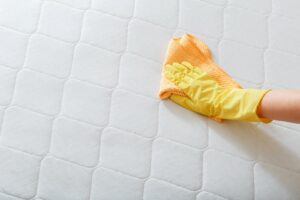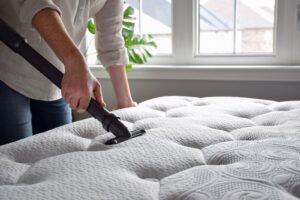How to Make Hospital Corners on Your Bed
If you enjoy a neatly made bed, you might consider using hospital corners. This method of tightly folding and tucking in bed sheets and blankets dates back to the 19th century. Before fitted sheets were invented, hospital corners provided a useful method for securing a flat sheet to a mattress.
Today, hospital corners remain a great way to give your bed a smooth and tidy appearance. They are also an ideal choice if you want your bedding to stay snug all night long. While hospital corners are most often seen in hospitals, hotels, and military settings, you can make them at home without much difficulty.
We’ll discuss the step-by-step process for making hospital corners and offer some tips for achieving the results you want. We’ll also look at the benefits of making your bed daily and how this simple habit can improve your sleep experience.
What Are Hospital Corners?
Hospital corners are created with a series of maneuvers that produce tight, diagonal folds near the foot of the bed. These folds make it difficult for sheets and blankets to come loose, bunch, or slip off the bed.
You can use hospital corners on the top sheet only or on additional bedding, depending on your preference. They result in a smooth sleep surface with distinctive folds, similar to those on a wrapped present, which start at the corners of the bed and angle downward along the sides of the mattress. When done correctly, no material hangs beneath the mattress, and the bedding is taut and wrinkle-free.
Making Your Bed With Hospital Corners: Step by Step
Before making hospital corners, strip your bed down to its fitted sheet — or, if you prefer, begin with a fresh fitted sheet. If you plan to use hospital corners on a blanket, quilt, or comforter in addition to sheets, you can follow these steps simultaneously or separately for each layer, depending on the desired effect.
- Lay the top sheet down. Start by laying the top sheet over the fitted sheet. Align the top edge of the sheet with the edge of the mattress at the head of the bed, and ensure that the sheet hangs evenly on all remaining sides of the bed.
- Tuck in the sheet at the foot of the bed. At the foot of the bed, lift the mattress enough to tuck the bottom edge of the sheet underneath. Begin at one corner and work your way along the foot of the bed, ensuring that the sheet tightly hugs the mattress at that end of the bed.
- Create a flap over a corner of the mattress. Move to one side of the bed, and position yourself about 12 to 18 inches up from the corner at the foot of the bed. Take hold of the edge of the sheet directly in front of you. Lift that edge upward and fold it over the top of the mattress. This will create a flap with an outer fold that emerges from the corner of the bed at a 45-degree angle and a hidden inner fold that runs along the mattress edge.
- Tuck in the lower section of fabric. Some fabric will drape from the flap on top of the mattress over the side of the bed. Hold the flap in place with one hand, and use your other hand to tuck the excess fabric on the side of the bed under the mattress.
- Return the flap to the side of the bed and tuck in the remaining fabric. Take hold of the flap and gently lower it back over the side of the bed. Ensure that the outer fold of the flap hangs diagonally from the corner of the mattress. Along the entire side of the bed, tuck any loose fabric tightly beneath the mattress.
- Repeat steps 3 to 5. Move to the other side of the bed, and repeat steps 3 to 5 to complete the process. Your actions should mirror those you took when making the first hospital corner.
Other Tips and Tricks for Hospital Corners
Experts make hospital corners look easy, but they can be tricky the first time you try them. That said, there are some pointers that can help you quickly achieve the look and feel you desire.
- Smooth out bedding after every step: To create professional-looking hospital corners, make sure to smooth any wrinkles, bumps, or creases out of the sheets after each step.
- Consider your fabric: Hospital corners are much easier to create with sheets made of cotton, which stay in place and make crisper folds. Slippery materials, such as satin or those with a sateen weave, tend to slide and loosen more easily. Sharp creases may also be harder to achieve when using a buttery soft fabric like microfiber or a thick material such as fleece.
- Tighten or loosen your corners: To achieve the desired tension in your sheets and blankets, you may need to loosen or tighten the corners. Some people prefer their covers snugly tucked in across their body. For those who like to move their legs and feet around, a looser hospital corner is best.
- Complete layers separately: If you have multiple sheets and blankets or a thick duvet and want hospital corners on all your bedding, it might be easier to complete hospital corners on each layer separately. This will help you avoid having to wedge a large amount of material under the mattress at one time.
- Practice makes perfect: As with any new task, there’s a learning curve to making hospital corners. Expect to practice a few times before you get the hang of it.
Why It’s Important to Make Your Bed
Making your bed in the morning may help you get better sleep at night by supporting a stress-free nighttime routine. A made or turned-down bed makes climbing in much easier. Instead of having to arrange twisted, rumpled bedding, you can slide in and immediately begin trying to fall asleep.
The look of your bedroom — along with light, noise, and temperature levels — are important contributors to your sleep environment. As the focal point of the bedroom, your bed affects its overall appearance and feel. An unmade bed may give you the sense that you have things to do when you are trying to unwind. This could heighten stress levels, which might make it harder to fall or stay asleep.
On the other hand, a neatly made bed can evoke a sense of tidiness and order. Because a soothing sleep environment can help you get the rest you need, making your bed is a key step in creating the ideal bedroom for sleep.

Still have questions? Ask our community!
Join our Sleep Care Community — a trusted hub of sleep health professionals, product specialists, and people just like you. Whether you need expert sleep advice for your insomnia or you’re searching for the perfect mattress, we’ve got you covered. Get personalized guidance from the experts who know sleep best.









